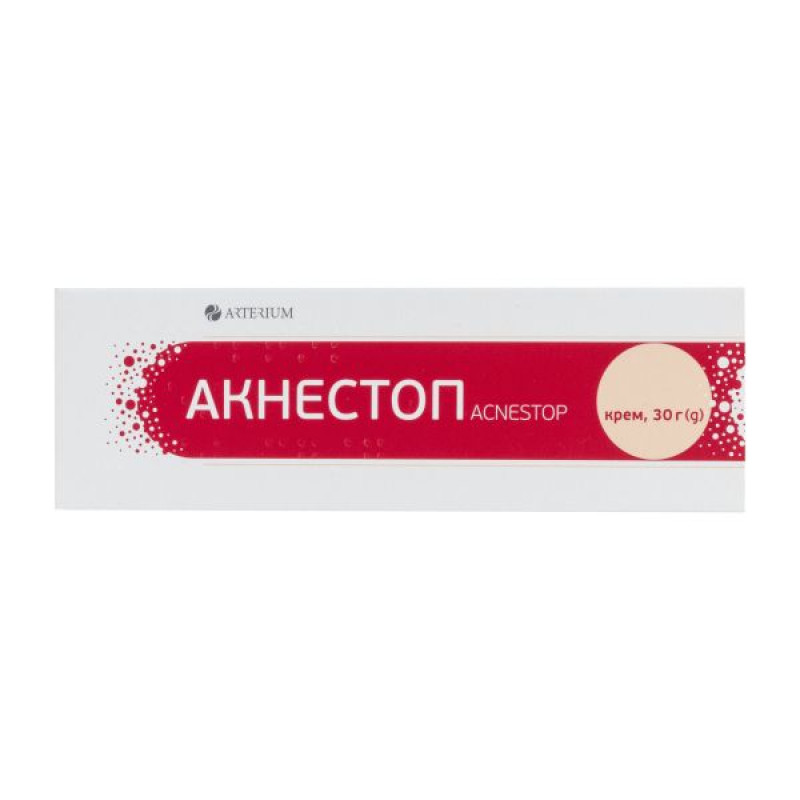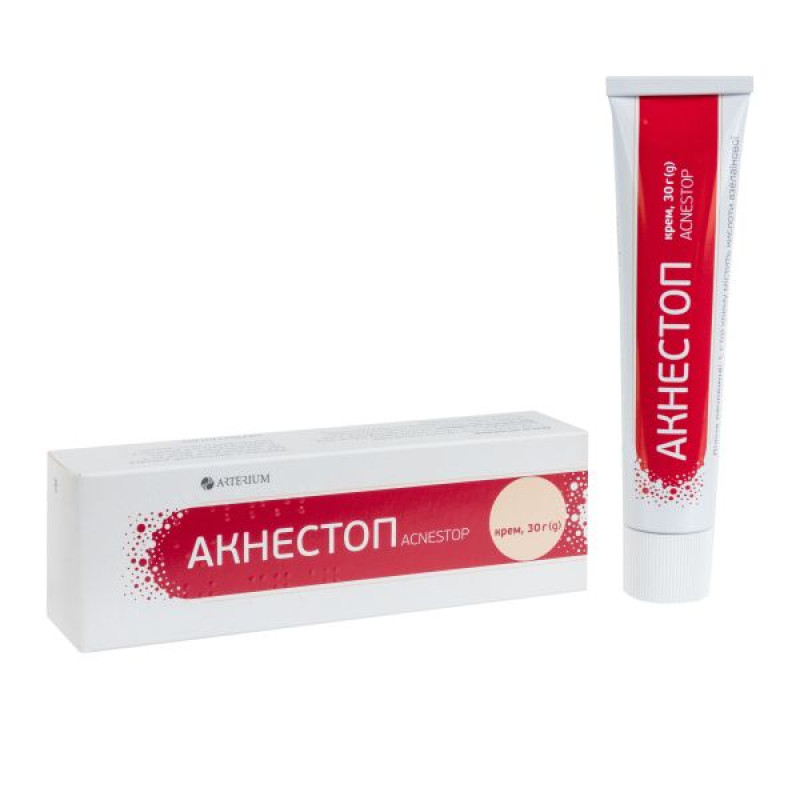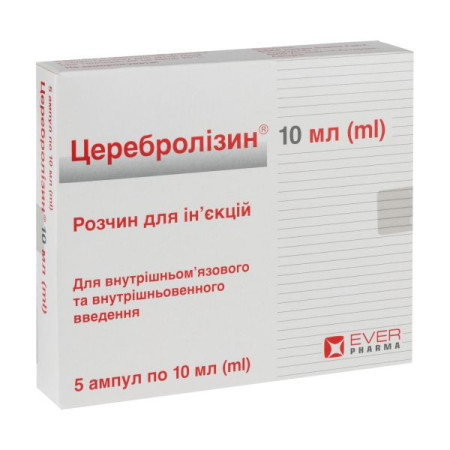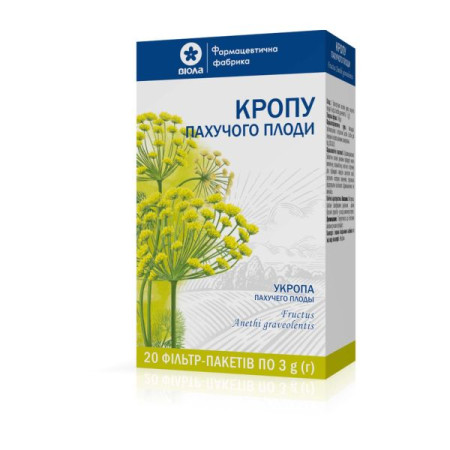Acnestop cream for external use 20% tube 30 g
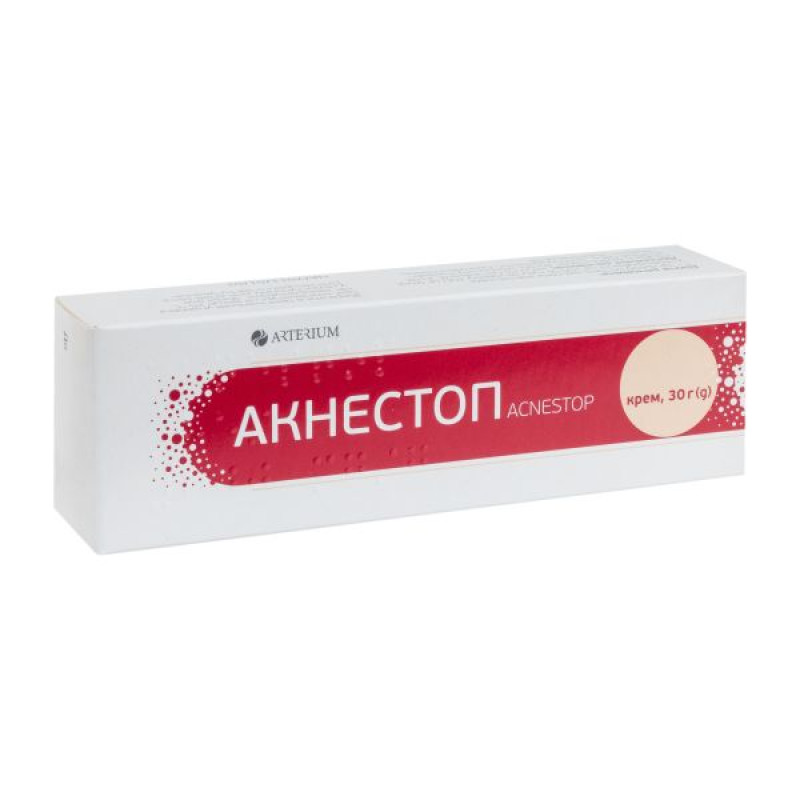
Instructions for use Acnestop cream for external use 20% tube 30 g
Composition
active ingredient: 1 g of cream contains 200 mg of azelaic acid, calculated on 100% dry matter;
excipients: benzoic acid (E 210), glycerol monostearate 40-55, macrogol stearate, "CUTINA CBS", octyldodecanol, propylene glycol, glycerin, purified water.
Dosage form
Cream.
Main physicochemical properties: white opaque cream.
Pharmacotherapeutic group
Topical remedies for acne treatment.
ATX code D10A X03.
Pharmacological properties
Pharmacodynamics
Azelaic acid, the active ingredient in Acnestop, is a naturally occurring straight-chain dicarboxylic acid that is free from toxicity, teratogenicity, and mutagenicity.
It is believed that the therapeutic effectiveness of Acnestop cream in the treatment of acne is due to its antimicrobial action and direct effect on follicular hyperkeratosis.
Clinically, a significant decrease in the density of Propionibacterium acnes colonization and a significant decrease in the fraction of free fatty acids in skin surface lipids are observed.
Azelaic acid inhibits keratinocyte proliferation in vitro and in vivo and normalizes the disruption of epidermal terminal differentiation processes in acne. In the rabbit ear model, azelaic acid accelerates comedolysis of tetradecane-induced comedones.
At a concentration of 0.31 - 2.5%, a biocidal effect is manifested after prolonged contact for 30-120 minutes against gram-positive and gram-negative aerobic bacteria, anaerobic bacteria and fungi.
In vitro studies have not demonstrated the presence of mutant forms resistant to azelaic acid in either Staphylococcus epidermidis or Propionibacterium acnes.
Pharmacokinetics
After application of the cream, azelaic acid penetrates all layers of human skin. Penetration occurs more rapidly through damaged skin than through intact skin. After a single application of 1 g of azelaic acid (5 g of cream) to the skin surface, 3.6% of the applied dose is absorbed subcutaneously.
Part of the azelaic acid adsorbed through the skin is excreted unchanged in the urine. The rest is broken down by β-oxidation to dicarboxylic acids with shorter chain lengths (C7, C5), which have also been detected in the urine.
Systemic tolerability studies after repeated oral and topical administration of azelaic acid have not revealed any indication that even under extreme conditions, such as application to a large area and/or occlusion, side effects can be expected.
Indication
Treatment of acne (acne vulgaris), characterized by the presence of comedones, papules, pustules and small nodules.
Contraindication
Hypersensitivity to the active substance or to any of the excipients of the medicinal product.
Interaction with other medicinal products and other types of interactions
Interaction studies have not been conducted.
No drug interactions were observed during controlled clinical studies.
Azelaic acid is chemically incompatible with alkalis, strong oxidizing agents, and reducing agents.
The composition of the cream does not allow us to expect any undesirable interactions of individual components that could negatively affect the safety of the drug.
Application features
For external use only. Do not allow the cream to get into the eyes, mouth or mucous membranes. If the product gets into the eyes, mouth or mucous membranes, rinse them immediately with plenty of water. If eye irritation persists, it is recommended to consult a doctor. Wash your hands after each application of the cream.
Concomitant use of cosmetic products, alcoholic or aggressive detergents, tinctures, astringents or abrasives or exfoliants should be limited during treatment as much as possible.
Benzoic acid may cause mild irritation to the skin, eyes, and mucous membranes. Propylene glycol may also cause skin irritation.
In rare cases, exacerbation of bronchial asthma has been reported in patients receiving azelaic acid during post-marketing surveillance.
Ability to influence reaction speed when driving vehicles or other mechanisms
No effect.
Use during pregnancy or breastfeeding
Pregnancy.
There are no adequate and well-controlled studies of topical azelaic acid preparations in pregnant women.
Animal studies do not indicate direct or indirect harmful effects with respect to pregnancy, embryonal/fetal development, parturition or postnatal development.
Pregnant women should use the drug with caution.
It is not known whether azelaic acid is secreted into breast milk in vivo. However, an in vitro experiment has shown that the active substance may be excreted in breast milk. It is expected that the distribution of azelaic acid in breast milk will not lead to significant changes in its basal level, since it does not concentrate in breast milk and less than 4% of topically applied azelaic acid is absorbed systemically (without increasing the endogenous exposure of the substance above physiological levels). However, caution should be exercised when using the drug in breastfeeding women.
The infant should avoid contact with the skin/breast treated with the drug.
Method of administration and doses
Apply Acnestop cream 2 times a day (morning and evening) to the affected areas of the skin and rub in gently. Approximately 0.5 g = 2.5 cm of cream is enough for the entire face. Before applying Acnestop cream, the skin should be thoroughly washed with water and dried. You can also use a mild cosmetic cleanser.
It is important to use Acnestop cream regularly throughout the entire course of treatment.
The duration of the course of treatment may vary depending on the individual course of the disease and is determined by the degree of its severity.
In patients with acne, noticeable improvement is usually observed after about 4 weeks. However, to achieve optimal results, it is recommended to use Acnestop continuously for several months. There is clinical experience with continuous use of topical azelaic acid for up to 1 year.
In case of excessive skin irritation (see section "Adverse reactions"), the amount of cream to be applied or the frequency of application of Acnestop cream should be reduced to 1 time per day until the irritation disappears. If necessary, therapy can be temporarily interrupted for a few days. After a short period of treatment without noticeable results, a repeated medical evaluation is necessary.
Children.
Use in adolescents aged 12 years and over. There is no need for dose adjustment when prescribing Acnestop cream to adolescents aged 12 years and over. The safety and efficacy of Acnestop cream in children under 12 years of age have not been established.
Overdose
The results of acute toxicity studies do not indicate any risk of acute intoxication in the event of a single overdose (application of the cream to a large surface area of the skin under conditions favorable for adsorption) or in the event of accidental ingestion.
Adverse reactions
The frequency of adverse reactions was determined according to MedDRA: very common (≥1/10); common (≥1/100 to <1/10); uncommon (≥1/1000 to <1/100); rare (≥1/10000 to <1/1000); very rare (<1/10000), frequency unknown (cannot be estimated from the available data).
Skin and subcutaneous tissue disorders: uncommon – seborrhea, acne, skin depigmentation; rare – cheilitis (inflammation of the lips), rash.
Local disorders: very common - burning, itching and erythema; common - peeling, pain, dryness, skin discoloration and irritation at the application site; uncommon - paresthesia, dermatitis, discomfort and swelling at the application site; rare - urticaria, ulcer at the application site; rare - vesicles, eczema, feeling of warmth and ulcer at the application site. Usually local skin irritations resolve during treatment.
Immune system disorders: rarely - hypersensitivity.
Cases of exacerbation of bronchial asthma symptoms have been reported in patients using azelaic acid (frequency unknown).
If any undesirable effects occur, including those not listed in this instruction, you should inform your doctor.
Local tolerability of the drug in children aged 12 years and older is similar to that in adult patients.
Expiration date
2 years.
Storage conditions
Store in the original packaging at a temperature not exceeding 25 ° C. Do not freeze. Keep out of the reach of children.
Packaging
30 g in tubes, 1 tube in a pack.
Vacation category
Without a prescription.
Producer
PJSC "Kyivmedpreparat".
Location of the manufacturer and its business address
Ukraine, 01032, Kyiv, Saksaganskoho St., 139
There are no reviews for this product.
There are no reviews for this product, be the first to leave your review.
No questions about this product, be the first and ask your question.







